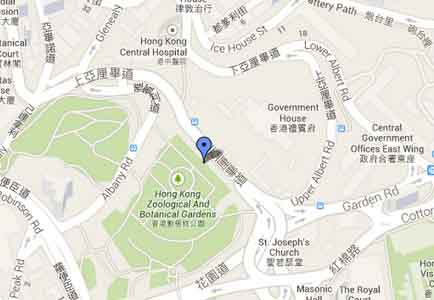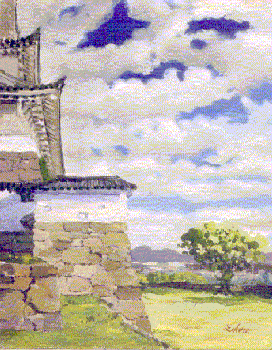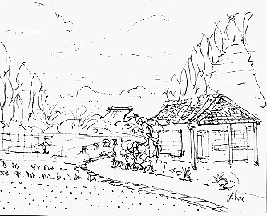 Asian Paintings
Asian Paintings Asian Paintings
Asian PaintingsInspiring Smiles Forever
Complete Works, Portraits, Landscapes, Still Lifes, Sculpture, Lego Artist...
Sign up for yearly notices by sending an e-mail to newart-subscribe@tomlohre.com
Post comments on https://www.facebook.com/LohreFineArt
The Asian Story
Our most gracious host Yuso Hase in Tokyo has three tips for his countrymen who go to America. Do not slurp your soup if it has no noodles. The Japanese hold their noodle soup up to their mouth and slurp, shoveling the noodles in with their chop sticks. Do not say yes when you mean you understand. The Japanese have the habit of saying "Hite"(Yes) many times during a conversation meaning that they understand what you are saying, but in the US that could mean you agree to what is being said. The third thing was no smoking. Smoking cigarettes is a big thing. I believe cigars will eventually have a huge market there when the Japanese stop smoking from habit.
My Grandmother Higgins spent some time in the Philippines. Grandfather was a
tank commander in the Army and they spent a few years there. My mother learned
to speak the Tigala language, she was three! She said that when they left the
Philippines, by boat, a whale followed them all the way across the Pacific!
Upon leaving Kobe we stayed two nights at a Japanese style inn located on the grounds of the Mishima fertility shrine in Kyoto. The fertility ceremony was performed by the shrine's monk who also was the inn keepers. Irene is not supposed to eat eel for two weeks! As it turns out the Mishima Shrine is the same shrine for eel farmers. Eel tastes a lot like catfish. It is a freshwater fish that goes out to sea and returns much like salmon! The shrine quite hidden and it took us a full three hours to find it. Of course, the big drawback was the language and in the end I had to match line for line the symbols of the Japanese language to find the street! We focused on learning Japanese. Cantonese is tonal and difficult to learn.
In Kyoto we hooked up with my friend Yuso. I had painted his portrait in NYC
ten years ago! We quickly traveled to many shrines under his prefect tutelage.
Golden Pagoda, Zen rock garden and Gisha girls all came our way and enthralled
us. The weather was prefect Fall and the colors could only be topped by the
Spring cherry blossoms.
Japan is homogeneous in terrain and people from top to bottom. Only the crops
vary according to weather and latitude. There are persimmon trees in Tokyo.
Tea and oranges grow just a little South of Tokyo. Once back in Tokyo we had
two days left on our rail pass and took two-day trips. One to a small city just
a hour South and another to a city on the Sea of Japan. To get to the later
we took the bullet train right through the Japanese alps. Twenty minutes in
a tunnel going 120 miles per hour is quite a experience! In the North they tie
up the pine trees and bushes, so the snow does not distort the fine work of
the pruners. Pruning and landscaping is rampant in Japan. If I did some of the
things to the trees here that they do there I would be arrested!
We ate a lot of noodles. Always a bowl of noodles with a main dish of rice and
fish. They make the noodles by stretching the dough until it is as thin as possible.
The water makes them expand to about one eighth inch in diameter. The tempura
was exceptional. We dined as quests at the best tempura restaurant in Tokyo.
Irene's Japanese roommate from UNC husbandís uncle treated us. He was a pilot
in WW II. His first mission was August 17th, 1945. On the way to bomb the American
base at Saipan he was called back because the Japanese had surrendered! He would
have surly died. Those missions were kamikaze, without enough fuel to return.
I bought Japanese WW II boots. More like cloth high top socks with a thin rubber
sole. The toes and big toe separated so they could slip into sandals. The old
workmen wear them with breeches.
Irene and I visited the incendiary bombing display at the Edo Museum. 200,000
people died in the fires of Tokyo, more than the atomic bombs dropped. Japanese
housing is wood frame with mud walls making fire a big problem. Many of the
Shrines and Temples are destroyed by fire. The terrain of Japan is homogeneous.
The volcanic mountains eroded to create vast flatlands that in circle the mountains.
People do not live in the mountains causing them to live in small plots surrounded
by rice patties and vegetable plots. Fishermen work the hundreds of canals caused
by the drainage from the mountains. Japan is a country of endless canals.
The big part of Japan's people is their homogeneous wealth. All except the illusive
poor and corporate heads are just about in the same income bracket. There is
insulation from foreign competition. When the Japanese change they change from
the top down. The Japanese change all at once. If the government decided that
it was ok to eat foreign rice, then the next day all of the Japanese would eat
foreign rice! Rice, telephone service and banking are all uniquely Japanese.
To obtain a new telephone line is a very expensive and lengthy process so most
of the young people have mobile phones! Not embarrassing others is a big part
of the Japanese way. Making inroads into their market is just as easy as finding
a way for a win win situation!
Governor's Home, Hong Kong, 12" x 16", oil on canvas, painted from life 1994

Tom set up for his first work in the Orient and discovered he left his white and red oil paint at home. He broke down his stand and spent the next two hours finding an art store. Ending up taking two buses into town, navigating the incredible culture shock to get to a typical art store in a major city, finally around three in the afternoon he started and finished this work while in the Zoo overlooking the Governorís Home. So much building was replacing old homes this building preserves the old style.
Hong Kong Harbor, 10" x 8", oil on canvas, 1994
President Clinton told the head of China that the environment is the biggest problem for them. You can realize why he said that after experiencing the pollution in China and Hong Kong. I hear that it is much worst in Bangkok. It would seem that pollution does not have to be a aspect of advancement. China uses a lot of foam food cartons. They litter the shores and waterways.
Chinaman, 10" x 8", Oil on board, November 13, 2010, variation using nine color pallette
Chinaman III, 10" x 8", Oil on canvas, 2001, 10" x 8" Ink Jet print
Chinaman II, 10" x 8", Oil on canvas, 2001, 10" x 8", 1996
Chinaman I, 10" x 8", Oil
on canvas, 2001, 10" x 8", 1994, original painting done in China

Himeji Castle, Kyoto, Japan, 8" x 10", oil on canvas, 1994
After a day in Tokyo we took the bullet train to Kobe to visited Irene's American friends, Kathleen & Stu. They are in Kobe because Proctor & Gamble's international headquarters is there. They live in a spacious high rise with four bedrooms and four baths. On the tenth floor you can see the fantastic harbor with the most modern facilities. The day before Thanksgiving we had dinner at a special Kobe beef restaurant. On Thanksgiving we visited Himeji Castle. I painted a small canvas and later met Irene and Kathleen at home. Thanksgiving dinner was the finest seasoned tofu!

Emiko's Home, 10" x 8", pencil on paper, 1994
After we got our Asian legs we spent several days with Irene's roommate from college. They treated us with exceptional hospitality and went way out of their way to accommodate us. Emiko and Kato live in the country on the Eastern peninsula of Tokyo Bay. Their home was most charming and a first class way for us to be introduced to Japanese living. We spend our time sight seeing and eating the most extraordinary foods. We sadly missed Emiko and Kato after they dropped us off at my friends home in Tokyo. The rental car even had a gps driven map. It showed where you were and what turns to take to your destination. It spoke in a female voice! In Japan they place such high taxes on vehicles yearly that most are only a few years old.
Tokyo Canal, 16" x 12", oil on canvas, 1994
View Tom
Lohre' locations of paintings painted from life in a larger map. More
additions to come:()
Experience The Warm Feeling of Owning Original Art
Auctions on Everything but the House Current works Archived Items
See on
Special Web Sites, Family Tree, Friend's Links
Complete Works, Portraits, Landscapes, Still Lifes, Sculpture, Lego Robot Artist...
Experience the Warm Feeling of Owning Original Art
Sign up for yearly notices by sending an e-mail to newart-subscribe@tomlohre.com
Post your comments on https://www.facebook.com/LohreFineArt
126A West 14th Street, 2nd Floor Cincinnati, Ohio 45202-7535